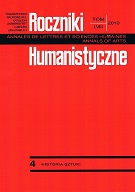W ciemnościach. Historia sztuki i sztuka dotyku
In the Dark. History of Art and the Art of Touch
Author(s): Gabriela ŚwitekSubject(s): Cultural history
Published by: Towarzystwo Naukowe KUL & Katolicki Uniwersytet Lubelski Jana Pawła II
Keywords: perception of art; reception of art; tactile experience; touch; percepcja sztuki; recepcja sztuki; doświadczenie taktylne; dotyk
Summary/Abstract: A dark room is a “research field” where an art historian moves with uncertainty. The strongest sensual experience that an art historian develops when his/her competence grows is seeing. The most valued trait of an art expert - a collector, museum specialist or an exhibition manager - is his/her “sharp eye”. The methodological paradigm that has dominated in art. history since the 1970s established the accepted “ways of seeing” art. The choice of touch for the subject matter of this paper is not meant as a challenge to the established hierarchy of senses underlying the above-mentioned research paradigm. The eye will stay in the centre of our research, even though not all art is created to be experienced through this sense only. This paper ventures an interpretative analysis of a selection of works which are not to be experienced solely through sight, but mostly by touch. Mirosław Bałka's installation entitled How It Is (2009-2010), exhibited in the London Tate Modern, Anthony McCalls works in his exhibition at the Serpentine Gallery (2007-2008), or Filippo Tommaso Marinetti's project called “the art of tactilism”, reaching back to the 1920s – these are examples of creations which make art. history grope around in the dark. The author does not aim to juxtapose sight and touch in art. interpretation, or to seek some "new empiricist" methodology. The paper is more of an attempt to criticise research tradition that favours sight over touch. Immediacy and elimination of distance are features that distinguish tactile experience from the visual one. In view of the fact that contemporary artistic practices strive to integrate and consolidate all sensual experiences in a holistic fashion, one can pose a crucial question of how to grasp and record the immediate tactile experience in the process of art-historical interpretation.
Journal: Roczniki Humanistyczne
- Issue Year: 58/2010
- Issue No: 04
- Page Range: 269-289
- Page Count: 21
- Language: Polish

